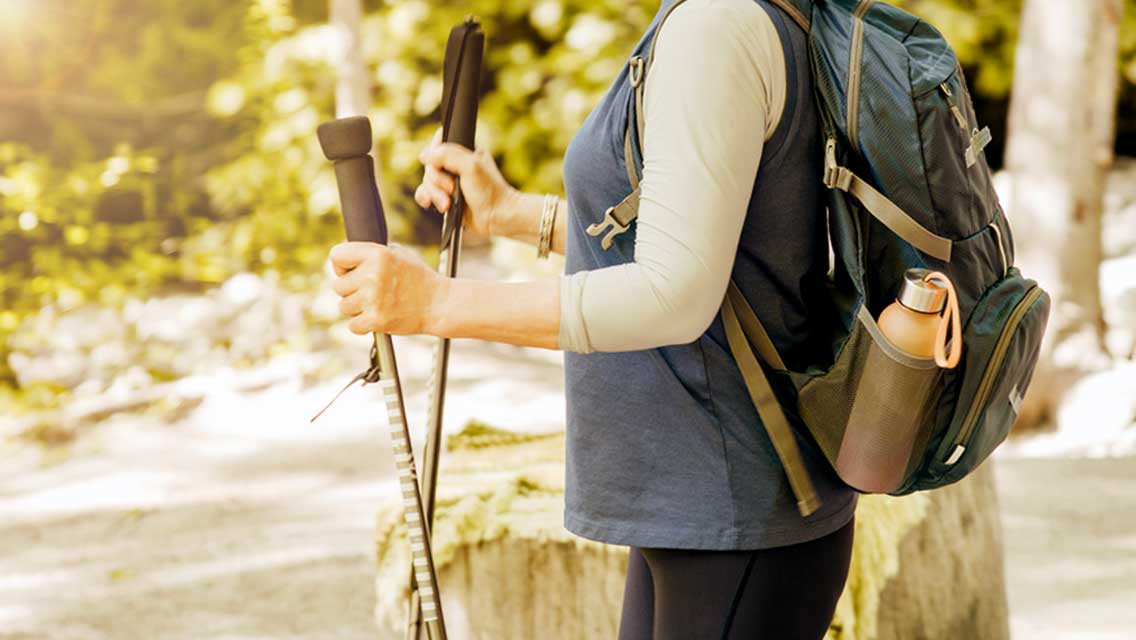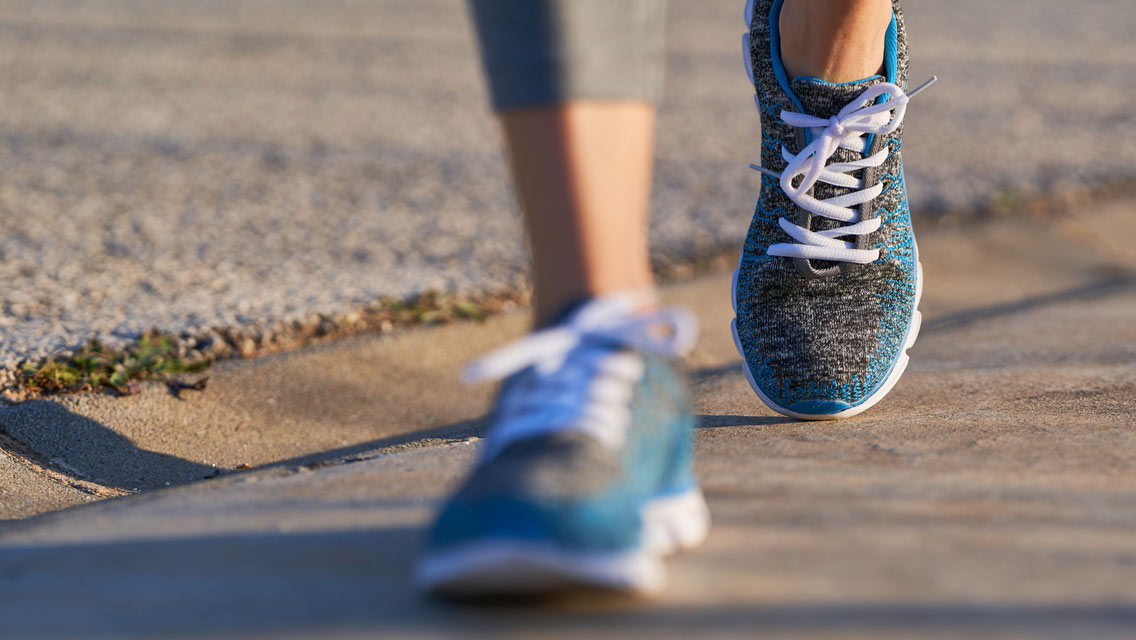Last fall, Kristine Carey was looking for something with more oomph than walking but less bone-jarring ouch than jogging. So when she bumped into neighbor Lori Raper striding purposefully with a pair of poles, Carey saw a new path to physical and mental fitness – especially when Raper confided that her jeans were fitting better. Soon, Carey, a marketing manager from Arvada, Colo., bought some poles of her own, and since then, she and Raper have been Nordic walking about four miles each morning. “You get a great workout,” says Carey, 40. “And Nordic walking has great social benefits, too – you can still talk while you walk.”
Experiences like Carey’s help to explain why so many people have embraced Nordic walking since it first gained popularity in Finland 10 years ago. More than 6 million people have discovered how using a simple set of poles burns up to 46 percent more calories and gives you a better total-body workout than regular walking – without making you feel like you’re working harder.
Sure, navigating tame suburban streets with what appear to be hiking sticks may strike some as odd. But, as Carey says, “Now, walking for exercise without poles would seem really silly.”
A New Way to Walk
As you might guess, Nordic walking evolved from Nordic skiing: It was an effective way for elite cross-country skiers to stay in shape after the snow melted. But nonskiers soon began adding poles to their own fitness walks, and, in 1997, a Finnish ski-pole company called Exel began to develop specialized walking sticks.
Unlike cross-country skiing, however, Nordic walking doesn’t require snow or planks of fiberglass clipped to your boots. All you need are ordinary walking or hiking shoes, workout wear to suit the weather, and a pair of Nordic walking poles – similar to cross-country poles, but with rubber tips and slightly snugger grips.
Nordic walking can be as strenuous or low-key as you make it. Just as with regular walking, you control the intensity by varying your stride and speed. Stacy Jochem of Waterville, Maine, discovered the activity at an L.L. Bean Employee Outdoor Adventure Day in June 2004, and she now walks regularly in the Vaughan Woods, a nearby patch of wilderness the locals call Hobbitland because of the woods’ resemblance to a setting in a Tolkien book – lush forest, moss-covered rocks, handmade stone bridges. “It’s one of the most relaxing places I’ve ever been,” says Jochem, 45.
But she also points out an emerging competitive side to the sport. Not only did she collaborate with the Maine Governor’s Council on Physical Activity to create a Nordic walking program, Jochem also worked to ensure that Nordic walkers were allowed entry into the 2006 Sportshoe Center Maine Marathon in Portland. (The sport’s official debut at a marathon was at the 2005 Portland Marathon in Oregon.) Nordic walking is also starting to appear in schools, at healthy-living rallies and in seminars around the country.
“Nordic walking is great for anyone who wants to take their cardio walking workouts to a new level, for anyone who has back pain and for anyone who needs to lose weight,” says Suzanne Nottingham, the director of Nordic walking education for pole manufacturer LEKI. “This is a seriously effective tool.”
The Pluses of Poles
The way the body responds to the poles explains why Nordic walking is so beneficial to health and fitness. “The caloric response to walking with sticks is higher,” says Conrad Earnest, PhD, director of exercise testing at the Pennington Biomedical Research Center in Baton Rouge, La. “This is due to the integration of the arms into the leg work,” he says.
In a 2002 study, Earnest and fellow researchers reported that Nordic walking also boosts heart rates more effectively than regular walking and increases oxygen consumption by more than 20 percent – without increasing perceived exertion.
By burning more calories, Jochem says she lost an inch and a half off her love handles in the first two weeks of consistent Nordic walking. “After a couple of months, my torso and arms became more toned – no more rippling skin when I waved to people,” she says. “And my butt got firmer – no more droopy derriere. I also didn’t get out of breath so frequently, and my posture improved.”
The poles can even help to improve spinal and muscle alignment, says Nottingham. She explains that poles allow walkers to “receive” the terrain through the rubber tip, and then press back into it without impact. This stabilizes head weight over the shoulder girdle and pelvis, which in turn stabilizes the spine and promotes muscle balance throughout the body. “Participants reap the benefits of back health without necessarily even knowing what they are doing for themselves,” she says.
On regular walks, it’s easy for body parts other than the legs to get lazy. Not so with Nordic walking, which uses up to 90 percent of your muscles, according to Rachel Duckham, MS, a physiologist in the Sports Development Center at Loughborough University in the United Kingdom and member of the American College of Sports Medicine.
“During Nordic walking, a greater number of muscle groups within the body are recruited,” she says. “You’ll really feel both the upper- and lower-extremity muscles. In the upper body, for example, you’ll notice your triceps muscles in your arms and your abdominal muscles in the trunk. In the lower body, you’ll recruit your hamstrings, quadriceps and calf muscles.”
Life-Balance Benefits
Kristin Rau, 38, a consultant from Denver, Colo., has found that Nordic walking has toned her arms and improved her core strength. “The poles help to keep everything in perfect balance,” she says. “It becomes a sort of dance.”
As a marathon runner, however, Rau didn’t adopt the sport for its caloric burn, which she was already getting from her long runs. Instead, it was a way for her to connect with friends while doing low-impact training – yet another benefit of the activity.
Jochem has found dozens of new pals through “poles,” while Lindy Spiezer of LEKI has strengthened family bonds. “My daughter and I go Nordic walking two times a week,” she says. “We call these nighttime sessions Nordic talking!”
Walk This Way
Like anything that sounds too good to be true, there is a catch to Nordic walking: learning to do it right.
If you’re just carrying the poles without much thought, explains Bernd Zimmermann, founder of the American Nordic Walking Association, you’re only in two-wheel drive, the same as regular walking. Getting into four-wheel drive means gripping the poles every time they hit the ground and then letting them go as they are drawn back behind your body. (The pole won’t fall out of your hand because the pole’s strap secures it.)
Four-wheel drive also requires an active upper body, keeping the poles close to your torso and leaning slightly forward. As your arms move the poles, your torso and hips should move in a slight counter-swinging motion. This effectively works the midtorso muscle groups. “When you are using the poles correctly, this is a full-body workout,” says Zimmermann.
The best way to get started with Nordic walking? Physiologist Duckham suggests just walking naturally, but taking slightly longer strides. Keep your shoulders relaxed with your head in a neutral position. (For more suggestions, see “Tip-Top Technique,” below.) People with a bit of inline skating or cross-country skiing experience tend to pick up Nordic walking quicker than others, says Nottingham, one of hundreds of instructors around the country helping newbies take their first steps. “But anyone can learn quite easily.”
Hmm. A fitness activity that’s easy, fun, convenient and effective? When you think about it that way, walking without poles starts sounding like a silly concept indeed.
Nordic Walking Technique
Proper form is key to obtaining the optimal benefits of Nordic walking. Follow these steps from the American Nordic Walking Association and pole manufacturer LEKI:
- Keep your shoulders relaxed and down, your elbows close to your body, and your arms straight but relaxed.
- Begin each step with your heel touching the ground, then roll forward to the ball-and-toe area, where you push off to propel yourself forward.
- As your right lead arm moves forward along with the opposing left foot, the right rubber pole tip remains slightly behind the body, aligned with the heel of the right foot.
- Always keep your poles pointing diagonally backward.
- Push the pole as far back as possible, creating a line parallel to the line of your back leg.
- Your hands should constantly be in a “grip-‘n’-go” state with the pole: Grip the pole every time it strikes the ground, then let go as it’s drawn back behind your body during your forward movement. Finish with your hand open.




This Post Has 0 Comments